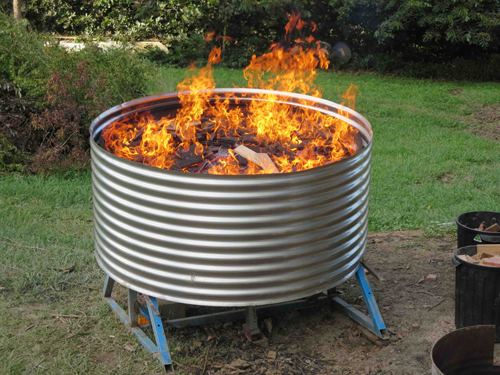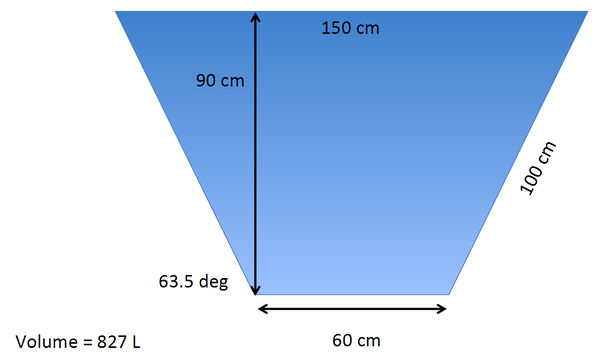Kon-Tiki Kiln
Excellent open source pyrolysis kiln from Switzerland for biochar production with a very clean burn. Some implements are already available and everything is open source. If you would like to support the further development of this effort, please consider donating to Ithaka Institut.
Ithaka Institut writes: While most of the biochar produced during the last 5000 years was produced with open fire, modern pyrolysis suppresses the fire. The separation of the carbonisation and the flaming of the pyrolysis gases make pyrolysis technology prone to failure and expensive which is one of the reasons why the biochar technology did not have yet it's breakthrough. The Kon-Tiki flame curtain kiln re-connects biochar making to the ancient wisdom and craft of fire making and combines it with smart design based on modern thermodynamics to produce high quality char with low emissions.
Assessment
My (Rasmus) opinion: these types of open-burn kilns appear to have some advantages over those "barrel-in-a-barrel" retorts that were advocated in the past. This kiln does away with the internal metal barrier which is costly, corrodes easily and is labor-intensive to make. Instead, it has a "flame cap": the flame itself is the cap. The Kon-Tiki kiln can be tilted after the burn, allowing the biochar to be dumped out easily for further use. The char produced with open burn kilns may be of higher quality, because volatiles and tars can evaporate more easily (a recent paper provides supporting evidence for this). The Kon-Tiki Kiln can be quenched with water. This "quench water", which is soapy and alkaline (due to a certain ash content), is a potentially valuable byproduct that can be used in other processes.
Video
Specifications
Production capacity:
- 700 l biochar in 4 to 5 hours
- Yield: 25 to 30% (DM)
- Temperature at the surface of the blaze is around 620° to 660° C
- Some 30 to 50 cm into the blaze zone, temperatures reach 750° C
Use of char in a charcoal gasifier to power an internal combustion engine
The char produced by this kiln is very clean compared to many other charcoal-making methods, i.e. it appears to have a very low content of volatiles/tars. An additional gasification step ("charcoal gasification"), would result in a very low-tar flammable gas. This gas can then power an internal combustion engine that basically requires no modifications. The sticky tars are avoided, so the internal combustion engine should be longer-lived than one run on wood gas. Obviously, no biochar is produced in this way, and all of the biomass would be used for energy.
Comment about this from Hans-Peter Schmidt (Ithaka Institut): "The gasification of high quality Kon-Tiki char is a valuable solution. In that case the biochar should not be quenched with liquids but covered with an iron lid that should then be covered with soil to make it tight. It will take then 8 to 16 hours to finish the burn and use the dry char for clean combustion. However, you could also install a screw discharger at the bottom of the kiln and transport the hot and dry char directly into a gasifier."
(For more details on the discussion of woodgas vs. charcoal gasification, see Troy Martz Gasifier.)

As heat source for other applications
This kiln produces large amounts of “waste” heat that could be used productively. The main issue to consider is that the “open burn” principle has to be maintained: the ambient pressure in the pyrolysis reaction should not increase when heat is captured. This may be achievable with a smokestack of sufficient height and proper dimensions. However, careful calculations are in required.
- heat source for greenhouses
- heat source for Hydronic Heat System
- biomass drying
- as part of a small biorefinery or distillery (e.g. ethanol)
- food dehydration (see: Food Drying with Superheated Steam)
- for electricity generation using Thermoelectric Generators
Related Wiki Pages
- The Earth Pit Kiln is a more "primitive" technique that operates by the same "open burn" principle as the steel kiln. It may be a good way to get started with this type of pyrolysis.
- Biochar and The Biochar Economy
- Biochar Crusher
Links
- "Kon-Tiki - the democratization of biochar production" (The Biochar Jourrnal) (read this! - internal copy here)
- same, formatted as a paper: *Ithaka Inst.: "Download the presentation of the Kon-Tiki technology" (.pdf)
- Internal copy of a presentation about this kiln by Ithaka Institut, has many images and design specifications, complements the paper nicely (original source here!)
- More videos from Ithaka Institut
- "Charmaking in the Himalayas" (The Biochar Journal) - has picture of full-scale “flat pack” 1000 liter Kon-Tiki
- "Biochar Production in Kon-Tiki Australia" - many pictures and design drawings from website "The Biochar Revolution"
- Paper in PLOS One:"Emissions and Char Quality of Flame-Curtain "Kon Tiki" Kilns for Farmer-Scale Charcoal/Biochar Production"

